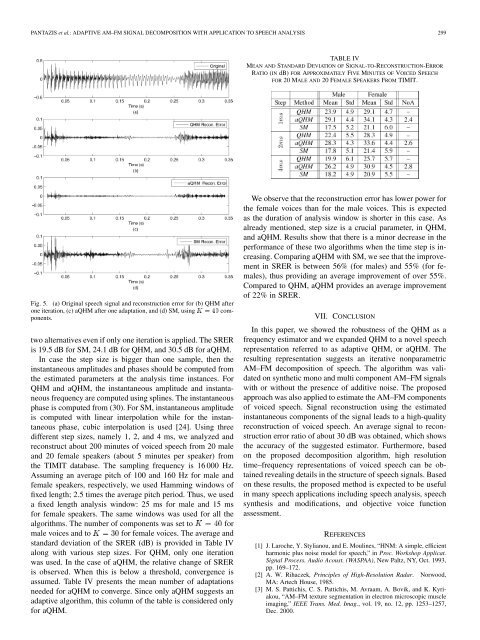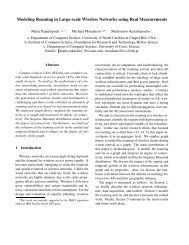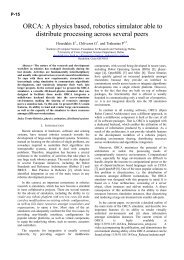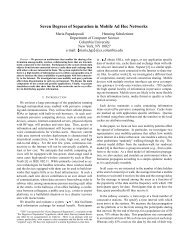PANTAZIS et al.: ADAPTIVE <strong>AM–FM</strong> SIGNAL DECOMPOSITION WITH APPLICATION TO SPEECH ANALYSIS 299 TABLE IV MEAN AND STANDARD DEVIATION OF SIGNAL-TO-RECONSTRUCTION-ERROR RATIO (IN dB) FOR APPROXIMATELY FIVE MINUTES OF VOICED SPEECH FOR 20 MALE AND 20 FEMALE SPEAKERS FROM TIMIT. Fig. 5. (a) Original speech signal and reconstruction error for (b) QHM after one iteration, (c) aQHM after one adaptation, and (d) SM, using K =40components. two alternatives even if only one iteration is applied. The SRER is 19.5 dB for SM, 24.1 dB for QHM, and 30.5 dB for aQHM. In case the step size is bigger than one sample, then the instantaneous amplitudes and phases should be computed from the estimated parameters at the analysis time instances. For QHM and aQHM, the instantaneous amplitude and instantaneous frequency are computed using splines. The instantaneous phase is computed from (30). For SM, instantaneous amplitude is computed with linear interpolation while for the instantaneous phase, cubic interpolation is used [24]. Using three different step sizes, namely 1, 2, and 4 ms, we analyzed and reconstruct about 200 minutes of voiced speech from 20 male and 20 female speakers (about 5 minutes per speaker) from the TIMIT database. The sampling frequency is 16 000 Hz. Assuming an average pitch of 100 and 160 Hz for male and female speakers, respectively, we used Hamming windows of fixed length; 2.5 times the average pitch period. Thus, we used a fixed length analysis window: 25 ms for male and 15 ms for female speakers. The same windows was used for all the algorithms. The number of components was set <strong>to</strong> for male voices and <strong>to</strong> for female voices. The average and standard deviation of the SRER (dB) is provided in Table IV along with various step sizes. For QHM, only one iteration was used. In the case of aQHM, the relative change of SRER is observed. When this is below a threshold, convergence is assumed. Table IV presents the mean number of adaptations needed for aQHM <strong>to</strong> converge. Since only aQHM suggests an adaptive algorithm, this column of the table is considered only for aQHM. We observe that the reconstruction error has lower power for the female voices than for the male voices. This is expected as the duration of analysis window is shorter in this case. As already mentioned, step size is a crucial parameter, in QHM, and aQHM. Results show that there is a minor decrease in the performance of these two algorithms when the time step is increasing. Comparing aQHM with SM, we see that the improvement in SRER is between 56% (for males) and 55% (for females), thus providing an average improvement of over 55%. Compared <strong>to</strong> QHM, aQHM provides an average improvement of 22% in SRER. VII. CONCLUSION In this paper, we showed the robustness of the QHM as a frequency estima<strong>to</strong>r and we expanded QHM <strong>to</strong> a novel speech representation referred <strong>to</strong> as adaptive QHM, or aQHM. The resulting representation suggests an iterative nonparametric <strong>AM–FM</strong> decomposition of speech. The algorithm was validated on synthetic mono and multi component <strong>AM–FM</strong> signals with or without the presence of additive noise. The proposed approach was also applied <strong>to</strong> estimate the <strong>AM–FM</strong> components of voiced speech. <strong>Signal</strong> reconstruction using the estimated instantaneous components of the signal leads <strong>to</strong> a high-quality reconstruction of voiced speech. An average signal <strong>to</strong> reconstruction error ratio of about 30 dB was obtained, which shows the accuracy of the suggested estima<strong>to</strong>r. Furthermore, based on the proposed decomposition algorithm, high resolution time–frequency representations of voiced speech can be obtained revealing details in the structure of speech signals. Based on these results, the proposed method is expected <strong>to</strong> be useful in many speech applications including speech analysis, speech synthesis and modifications, and objective voice function assessment. REFERENCES [1] J. Laroche, Y. Stylianou, and E. Moulines, “HNM: A simple, efficient harmonic plus noise model for speech,” in Proc. Workshop Applicat. <strong>Signal</strong> Process. Audio Acoust. (WASPAA), New Paltz, NY, Oct. 1993, pp. 169–172. [2] A. W. Rihaczek, Principles of High-Resolution Radar. Norwood, MA: Artech House, 1985. [3] M. S. Pattichis, C. S. Pattichis, M. Avraam, A. Bovik, and K. Kyriakou, “<strong>AM–FM</strong> texture segmentation in electron microscopic muscle imaging,” IEEE Trans. Med. Imag., vol. 19, no. 12, pp. 1253–1257, Dec. 2000.
300 IEEE TRANSACTIONS ON AUDIO, SPEECH, AND LANGUAGE PROCESSING, VOL. 19, NO. 2, FEBRUARY 2011 [4] T. F. Quatieri, Speech <strong>Signal</strong> Processing. Upper Saddle River, NJ: Prentice-Hall, 2002, <strong>Signal</strong> Processing Series. [5] A. Rao and R. Kumaresan, “On decomposing speech in<strong>to</strong> modulated components,” IEEE Trans. Speech Audio Process., vol. 8, no. 3, pp. 240–254, May 2000. [6] L. Cohen, Time–Frequency Analysis. New York: Prentice-Hall, 1995. [7] P. J. Loughlin and B. Tacer, “On the amplitude- and frequency-modulation decomposition of signals,” J. Acoust. Soc. Amer., vol. 100, pp. 1594–1601, Sep. 1996. [8] F. Auger and P. Flandrin, “Improving the readability of time–frequency and time-scale representations by the reassignment method,” IEEE Trans. <strong>Signal</strong> Process., vol. 43, no. 5, pp. 1068–1089, May 1995. [9] D. Vakman, “On the analytic signal, the Teager-Kaiser energy algorithm, and other methods for defining amplitude and frequency,” IEEE Trans. <strong>Signal</strong> Process., vol. 44, no. 4, pp. 791–797, Apr. 1996. [10] J. F. Kaiser, “On a simple algorithm <strong>to</strong> calculate the ’energy’ of a signal,” in Proc. IEEE Int. Conf. Acoust., Speech, <strong>Signal</strong> Process. (ICASSP), Albuquerque, NM, Apr. 1990, pp. 381–384. [11] P. Maragos, J. Kaiser, and T. Quatieri, “On separating amplitude from frequency modulations using energy opera<strong>to</strong>rs,” in Proc. IEEE Int. Conf. Acoust., Speech, <strong>Signal</strong> Process. (ICASSP), San Francisco, CA, Mar. 1992, pp. 1–4. [12] B. Santhanam, “Multicomponent <strong>AM–FM</strong> energy demodulation with applications <strong>to</strong> signal processing and communications,” Ph.D., Georgia Inst. of Technol., Atlanta, 1997. [13] J. H. L. Hansen, L. Gavidia-Ceballos, and J. F. Kaiser, “A nonlinear opera<strong>to</strong>r-based speech feature analysis method with application <strong>to</strong> vocal fold pathology assessment,” IEEE Trans. Biomed. Eng., vol. 45, no. 3, pp. 300–312, Mar. 1998. [14] W. C. Pai and P. C. Doerschuk, “Statistical <strong>AM–FM</strong> models, extended Kalman filter demodulation, Cramer–Rao bounds and speech analysis,” IEEE Trans. <strong>Signal</strong> Process., vol. 48, no. 8, pp. 2300–2313, Aug. 2000. [15] T. F. Quatieri, T. E. Hanna, and G. C. O’Leary, “<strong>AM–FM</strong> separation using audi<strong>to</strong>ry-motivated filters,” IEEE Trans. Speech Audio Process., vol. 5, no. 5, pp. 465–480, Sep. 1997. [16] S. Mann and S. Haykin, “The Chirplet transform: A generalization of Gabor’s logon transform,” in Proc. Vision Interface. [17] L. Weruaga and M. Kepesi, “The Fan-Chirp transform for non-stationary harmonic signals,” <strong>Signal</strong> Process., vol. 87, pp. 1504–1522, 2007. [18] R. Dunn and T. F. Quatieri, “Sinewave analysis/synthesis based on the Fan-Chirp transform,” in Proc. Workshop Applicat. <strong>Signal</strong> Process. Audio Acoust. (WASPAA), Oct. 2007, pp. 16–19. [19] S. Peleg and B. Friedlander, “The discrete polynomial-phase transform,” IEEE Trans. <strong>Signal</strong> Process., vol. 43, no. 8, pp. 1901–1914, Aug. 1995. [20] G. Zhou, G. B. Giannakis, and A. Swami, “On polynomial phase signals with time-varying amplitudes,” IEEE Trans. <strong>Signal</strong> Process., vol. 44, no. 4, pp. 848–861, Apr. 1996. [21] M. Betser, P. Collen, G. Richard, and B. David, “Estimation of frequency for AM/FM models using the phase vocoder framework,” IEEE Trans. <strong>Signal</strong> Process., vol. 56, no. 2, pp. 505–517, Feb. 2008. [22] B. Friedlander and J. M. Francos, “Estimation of amplitude and phase parameters of multicomponent signals,” IEEE Trans. <strong>Signal</strong> Process., vol. 43, no. 4, pp. 917–926, Apr. 1995. [23] S. Gazor and R. R. Far, “<strong>Adaptive</strong> maximum windowed likelihood multicomponent <strong>AM–FM</strong> signal decomposition,” IEEE Trans. Audio, Speech, Lang. Process., vol. 14, no. 2, pp. 497–491, Mar. 2006. [24] R. J. McAulay and T. F. Quatieri, “Speech analysis/synthesis based on a sinusoidal representation,” IEEE Trans. Acoust., Speech, <strong>Signal</strong> Process., vol. ASSP-34, no. 4, pp. 744–754, Aug. 1986. [25] J. Laroche, “A new analysis/synthesis system of musical signals using Prony’s method. <strong>Application</strong> <strong>to</strong> heavily damped percussive sounds,” in Proc. IEEE Int. Conf. Acoust., Speech, <strong>Signal</strong> Process. (ICASSP), Glasgow, U.K., May 1989, pp. 2053–2056. [26] Y. Pantazis, O. Rosec, and Y. Stylianou, “On the properties of a timevarying quasi-harmonic model of speech,” in Proc. Interspeech, Brisbane, Australia, Sep. 2008, pp. 1044–1047. [27] Y. Stylianou, “Harmonic plus noise models for speech, combined with statistical methods, for speech and speaker modification,” Ph.D. dissertation, Ecole Nationale Supérieure des Télécomm., Paris, France, 1996. [28] S. M. Kay, Funtamentals of Statistical <strong>Signal</strong> Processing: Estimation Theory. Englewood Cliffs, NJ: Prentice-Hall, 1993. [29] P. S<strong>to</strong>ica, H. Li, and J. Li, “Amplitude estimation of sinusoidal signals: Survey, new results, and an application,” IEEE Trans. <strong>Signal</strong> Process., vol. 48, no. 2, pp. 338–352, Feb. 2000. [30] A. V. Oppenheim, R. W. Schafer, and J. R. Buck, Discrete-Time <strong>Signal</strong> Processing, 2nd ed. Englwood Cliffs, NJ: Prentice-Hall, 1989, <strong>Signal</strong> Processing Series. [31] Y. Pantazis, O. Rosec, and Y. Stylianou, “Chirp rate estimation of speech based on a time-varying quasi-harmonic model,” in Proc. IEEE Int. Conf. Acoust., Speech, <strong>Signal</strong> Process. (ICASSP), 2009, pp. 3985–3988. Yannis Pantazis received the B.A. and M.S. degrees in computer science from the University of Crete, Heraklion, Greece, in 2004 and 2006, respectively. He is currently pursuing the Ph.D. degree in signal processing from the University of Crete. Since 2003, he has been a member of Institute of Computer Science, FORTH, Heraklion, Greece. His research interests include speech analysis and synthesis, voice pathology, and signal modeling and estimation. Olivier Rosec (M’07) received the M.Sc. degree in electronics and the Ph.D. degree in signal processing both from the Université de Bretagne Occidentale, Brest, France, in 1995 and 2000, respectively. He is a Research Engineer at Orange Labs, Lannion, France. From 1996 until 1999, he was with the Acoustics and Seismics Department of IFREMER, Brest, as a Research Engineer. Since 2000, he has been a Research Engineer in signal processing within the Speech Synthesis Team, Orange Labs. His current research interests include speech modeling and analysis, speech modification and coding for concatenative synthesis, voice transformation, and voice conversion. Yannis Stylianou (M’95) received the Diploma of Electrical Engineering from the National Technical University of Athens, Athens, Greece, in 1991 and the M.Sc. and Ph.D. degrees in signal processing from the Ecole National Superieure des Telecommunications, ENST, Paris, France, in 1992 and 1996, respectively. He is an Associate Professor in the Department of Computer Science, University of Crete, and an Associate Researcher in the Networks and Telecommunications Labora<strong>to</strong>ry, Institute of Computer Science at FORTH. From 1996 until 2001, he was with AT&T Labs Research, Murray Hill and Florham Park, NJ, as a Senior Technical Staff Member. In 2001, he joined Bell-Labs Lucent Technologies, Murray Hill (now Alcatel-Lucent). Since 2002, he has been with the Computer Science Department, University of Crete and the Institute of Computer Science at FORTH. He has over 100 peer-reviewed papers, and holds nine U.S. patents. He is on the Edi<strong>to</strong>rial Board of the Journal of Electrical and Computer Engineering, Hindawi, Associate Edi<strong>to</strong>r of the EURASIP Journal on Speech, Audio, and Music Processing, and of the EURASIP Research Letters in <strong>Signal</strong> Processing. He is member of ISCA and the Technical Chamber of Greece. Prof. Stylianou is on the Board of the International Speech Communication Association (ISCA), member of the IEEE Speech and Language Technical Committee, and of the IEEE Multimedia Communications Technical Committee. He was Associate Edi<strong>to</strong>r for the IEEE SIGNAL PROCESSING LETTERS.
















